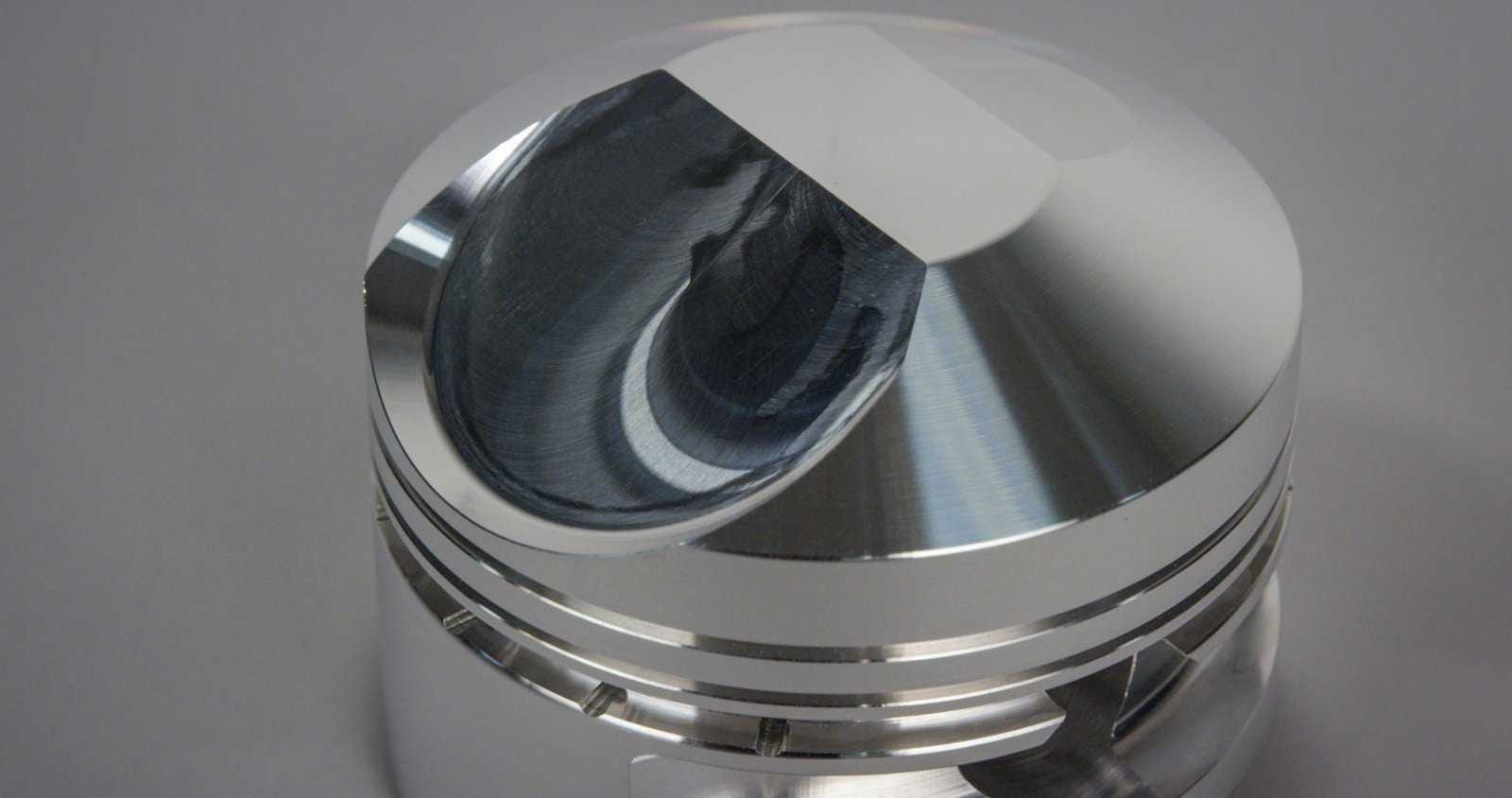Domed pistons increase compression ratios, enhancing power; flat-top pistons offer better fuel efficiency and less complexity. Domed and flat-top pistons both serve crucial roles in engine performance optimization.
Engine builders choose between domed pistons and flat-top pistons based on the desired balance of power and efficiency. Domed pistons deliver higher compression ratios, which can lead to increased horsepower and torque, making them a favorite for performance enthusiasts and racing applications.
On the other hand, flat-top pistons, with their uniform and level crowns, are known for promoting efficient combustion and reducing the likelihood of engine knocking. They are commonly found in everyday vehicles where reliability and fuel economy take precedence. The choice between these piston types affects an engine’s characteristics, including its power output, fuel consumption, and compatibility with various fuel octane ratings. Understanding the trade-offs between these piston designs is essential for engine tuners and manufacturers who aim to cater to diverse automotive needs.

Credit: www.facebook.com
Introduction To Piston Types
In the heart of every engine, pistons play a pivotal role. Their design has a significant impact on engine performance. Two primary types stand out: domed pistons and flat top pistons. Each serves unique purposes within an engine’s ecosystem. This guide delves into what makes each piston type distinct and how they influence an engine’s grunt.
Understanding The Role Of Pistons In An Engine
Pistons are crucial components that convert fuel into motion. Think of pistons as the engine’s sturdy workhorses. Their up-and-down movement generates the force needed to turn the wheels. Pistons must withstand extreme conditions while maintaining peak performance.
The Basics Of Domed Pistons
Domed pistons, with their characteristic bump on top, are designed for more power. This unique shape helps to compress the air-fuel mixture more intensely. It’s a trait sought after in high-performance engines. Here’s what sets domed pistons apart:
- Increased compression ratio
- Enhanced engine power
- Most common in racing applications
The Basics Of Flat Top Pistons
Flat top pistons, as the name suggests, come with a flat crown. These are the go-to for balance in power and efficiency. Their flat surface offers a cleaner burn of fuel for better emissions. Here are their key benefits:
- Improved fuel economy
- Better emissions profile
- Widely used in standard vehicles

Credit: www.jepistons.com
Performance Characteristics Of Domed Pistons
Examining the performance characteristics of domed pistons unveils insights into engine optimization. Domed pistons play an essential role in the functionality and output of high-performance engines. This section explores how domed pistons can influence the heart of a motor vehicle, shape its power, efficiency, and highlights some considerations that require attention for optimal performance.
How Domed Pistons Affect Compression Ratios
The compression ratio of an engine is a key factor in its performance. Domed pistons increase this ratio by reducing the volume of space above the piston at top dead center. A higher compression ratio leads to more forceful combustion, translating to more power on the downstroke. Simply put, domed pistons make the engine’s “squeeze” on the air-fuel mixture tighter, enabling a more potent explosion.
Impact On Engine Power And Efficiency
- Increased horsepower: The tighter compression provided by domed pistons can result in an increase in horsepower.
- Improved torque: Higher peak pressures in the combustion chamber due to higher compression often result in enhanced torque output.
- Better thermal efficiency: More efficient fuel usage occurs because of the improved combustion process, making the engine more fuel-efficient.
Potential Downsides: Detonation And Heat Management
With increased compression comes the risk of detonation, an unintended and damaging explosive event within the engine. High-performance engines with domed pistons must be finely tuned to avoid this. Additionally, due to their shape, domed pistons can complicate the airflow in the cylinder and lead to higher operating temperatures. Effective heat management strategies become essential to maintain engine stability and longevity.
Benefits And Limitations Of Flat Top Pistons
Exploring the world of automotive engines reveals a crucial debate between domed pistons and flat top pistons. Both possess unique characteristics, impacting engine performance significantly. Flat top pistons, known for their simplicity, have distinct advantages and limitations that we’ll analyze. These insights will guide users in making informed decisions regarding their engine’s internals.
The Advantages Of Flat Top Pistons In Engine Performance
Flat top pistons contribute greatly to engine efficiency and performance. Their flat surfaces make for predictable flame travel during combustion. This shape promotes more uniform combustion and a reduction in hot spots that can cause knocking. Here’s what they bring to the table:
- Enhanced Compression: They typically yield higher compression ratios.
- Better Flame Propagation: The flat surface aids in efficient air-fuel mixture burning.
- Less Turbulence: Smoothens the engine’s operation by creating less in-cylinder turbulence.
The Role Of Flat Top Pistons In Fuel Economy
Flat top pistons impact the economic aspect of engine running. First, the increase in compression can lead to better fuel efficiency. This is due to more complete combustion of the air-fuel mix. Higher efficiency means your engine can do more with less fuel. These pistons can make a significant difference in lowering fuel consumption. They support the engine’s production of more power per unit of fuel, aligning with eco-friendly driving goals.
Challenges Associated With Flat Top Pistons
Despite their merits, flat top pistons have some disadvantages. These include:
| Challenge | Description |
|---|---|
| Lower Tolerance for Knocking | Higher compression ratios increase the risk of engine knocking, especially with low-octane fuels. |
| Compatibility Concerns | Not every engine is designed to accommodate the higher compression ratios that flat top pistons produce. |
| Modification Costs | Engines may require additional modification to use flat top pistons to their full potential, raising costs. |
Each of these challenges requires attention. Users must consider the type of fuel used and the overall design of the engine before opting for flat top pistons.
Comparative Analysis: Domed Pistons Vs Flat Top Pistons
Comparative Analysis: Domed Pistons vs Flat Top Pistons dives deep into the heart of engine performance. Pistons play a vital role in an engine’s function. Two popular types, domed and flat top pistons, offer unique advantages. This analysis sheds light on how they compare across various aspects.
Compression Ratio And Combustion Dynamics
Domed pistons increase the compression ratio. This makes them ideal for high-performance engines. They do this by adding volume to the combustion chamber when the piston is at top dead center (TDC).
Flat top pistons maintain a more uniform combustion space. This leads to improved flame propagation. A more efficient burn occurs, which can enhance engine efficiency.
Engine Application Suitability
High horsepower engines often prefer domed pistons. These engines benefit from the higher compression ratio. It enables more powerful combustion.
Flat top pistons suit various applications. These range from daily driving cars to moderate performance vehicles. They offer a balance between power and efficiency.
Weight, Cost, And Durability Comparisons
Domed pistons are typically heavier. This can lead to more stress on engine components. They can also be costlier and potentially less durable over the long term.
Flat top pistons, on the other hand, are lighter. This usually means reduced engine stress. They are often more affordable and offer greater longevity.
Choosing The Right Piston For Your Engine
Choosing the right piston for your engine is crucial for peak performance. Whether you’re revving up for race day or just cruising, the piston shape you select – domed, flat-top, or otherwise – will have a significant impact on your engine’s power, efficiency, and overall health.
Considerations For High-performance Versus Daily Driving
Your choice of pistons can make or break your car’s performance. For high-performance machines, domed pistons often lead the charge, packing a punch with higher compression ratios that boost power. Yet, with great power comes increased stress on the engine.
For the daily driver, flat-top pistons may be the hero, offering better fuel efficiency, a smoother ride, and a longer-lasting engine.
Factors Influencing Piston Selection: Engine Type And Tuning Goals
- Engine Type: Your engine’s layout and design may favor one piston shape over the other.
- Compression Needs: Higher compression ratios call for domed pistons, while lower ratios are friendly to flat tops.
- Tuning Goals: Are you aiming for raw power or balanced performance? Your target sets the stage for piston selection.
Expert Recommendations And Best Practices
Here are some expert tips for selecting the right piston:
- Consult with engine builders and professionals.
- Consider your vehicle’s ultimate purpose and driving demands.
- Choose reliability for everyday driving; choose specialized pistons like domed for racing.
- Ensure your selection supports your engine’s overall setup.
Remember, the best piston for your engine aligns with your vehicle’s role and your performance ambitions.
Technical Developments And Future Trends
Domed pistons and flat top pistons hold great significance under the hoods of high-performance vehicles and everyday cars. Each possesses characteristics that impact an engine’s functionality and efficiency. Recent technical advancements push boundaries, enhancing piston operation and engine optimization. Let’s delve deeper into what the future holds in this vital component’s evolution.
Innovations In Piston Technology
Designers constantly seek ways to reduce weight while maintaining strength in pistons. Engineers have introduced pistons with intricate shapes and profiles. These features are precisely calculated to optimise combustion, leading to stronger yet lighter parts.
- 3D printing enables complex designs.
- Ceramic coatings reduce heat and friction.
- Dual-material pistons save weight and add resilience.
Emerging Materials And Manufacturing Techniques
New materials are emerging, defining the next generation of pistons. For example, metal matrix composites (MMCs) blend metals with other elements like ceramics. This pushes performance boundaries. Here’s how manufacturing evolves:
| Material | Properties |
|---|---|
| MMCs | High strength, low weight |
| Aluminum Alloys | Improved thermal efficiency |
| Titanium | Exceptional durability |
Advances in CNC machining and laser etching also enhance precision. This leads to tighter tolerances and better engine performance.
Predicting The Future Dynamics Of Piston Design
Tomorrow’s pistons are being shaped by today’s predictions. Analyzing market needs and performance metrics, experts foresee certain trends:
- Increased use of computer simulations for design.
- Hybrid designs that integrate best aspects of domed and flat top pistons.
- Focus on reducing emissions drives cleaner design philosophies.
Every stride in technology nudges pistons toward being smarter and more efficient. Domed pistons versus flat top is no longer just a comparison; it’s a canvas for innovation.

Credit: www.jepistons.com
Frequently Asked Questions For Domed Pistons Vs Flat Top
Are Flat Top Pistons Better Than Domed?
Flat top pistons generally offer better fuel efficiency and power in most engines, while domed pistons are designed for higher compression ratios in performance applications. The better choice depends on the engine’s intended use.
What Are The Advantages Of Dome Pistons?
Dome pistons enhance combustion efficiency and increase compression ratios, leading to improved engine power and performance. They also support precise flame propagation for better fuel economy.
Do Dome Pistons Make More Power?
Dome pistons can increase power by enhancing compression ratios in combustion engines, leading to more efficient fuel burn.
What Is The Most Efficient Piston Shape?
The most efficient piston shape is generally oval or slightly elliptical, optimizing balance between surface area and volume for performance in combustion engines.
Conclusion
Navigating the choice between domed pistons and flat top pistons just got simpler. Your decision hinges on desired compression, engine compatibility, and performance aims. Armed with the insights from this post, selecting the right piston type for your engine setup should be a breeze.
Forge ahead with confidence, knowing your engine’s heart is well-matched to your automotive goals.




